- By Dan Veaner
- Around Town
 Print
Print 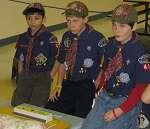 Sunday afternoon the Elementary School cafeteria was transformed into a race track to rival Watkins Glen. Lansing Cub Scout Pack 48 held their annual Pinewood Derby, with about 45 wooden cars racing in five age groups. Scouts across the country look forward to the event every year, and it is a long standing Lansing tradition.
Sunday afternoon the Elementary School cafeteria was transformed into a race track to rival Watkins Glen. Lansing Cub Scout Pack 48 held their annual Pinewood Derby, with about 45 wooden cars racing in five age groups. Scouts across the country look forward to the event every year, and it is a long standing Lansing tradition.Scout leaders met Saturday to set up the track. "We used to set it up after church on a Sunday," says scout leader Don Hradisky, referring to the time when the races were held at All Saints Church. " We had one hour to set it up and make it perfect. This is our third year in the school. We set it up on a Saturday and work all the bugs out, so on Sunday we walk in, sign the kids in and we're off to the races."
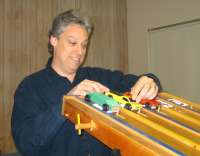 And what races! Each scout gets a kit that includes a block of wood, axles and wheels, from which they must create a car of their own design. All cars must have the same length and width, and may not weigh more than five ounces. "They can be under, but they won't be as fast," says Webelos 2 scout leader Roger Vandepoel.
And what races! Each scout gets a kit that includes a block of wood, axles and wheels, from which they must create a car of their own design. All cars must have the same length and width, and may not weigh more than five ounces. "They can be under, but they won't be as fast," says Webelos 2 scout leader Roger Vandepoel.A weigh station is set up at the front door, and cars that weigh less than the maximum may have lead weights taped on to help increase their speed. Some of the cars are designed for looks, and others for speed. Most have lead embedded in them to bring them up to the weight limit.
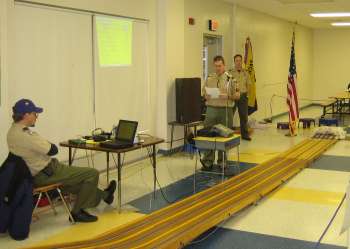 Mike Zieglermans the computer (left) while Don Hradisky (center) announces and Sheldon Craig stands by |
The computer announces the winner audibly, as well as displaying the names of the scouts and their cars' times on a screen, projected from the laptop computer that is running the program. This is an improvement over the photo finish method used in past years. Hradisky says, "When I started doing this we did it with a video camera to try to determine who won the race. It was a nightmare. We never had a video camera that would slow it down enough to really get an accurate view of who actually won. This is much easier."
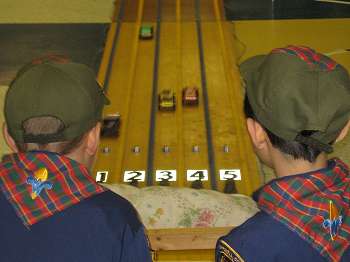
The Pinewood Derby was started by Don Murphy in Manhattan Beach, CA in 1953. He got a local aviation company to sponsor the event and pay for the track. it was so popular that the Los Angeles Recreation Department copied the event, and within only one year it was adopted for use by all cub scout troops. Locally the track that is used today was hand made in 1994 for Cub Scout Pack 26 by Thomas Bordoni with materials donated by Borg Warner. They used it to hold races there for family events and loaned it to Pack 48 each year for the derby. Recently they purchased a new track and donated this one to the scouts.
All the cub scout leaders got into the act with Mike Ziegler on the computer, Hradisky announcing the races, and Sheldon Craig, Jim Straight, Robert Cree and Vandepoel keeping things moving. Mark Wheeler, who had three sons racing Sunday, set up the cars at the starting line and Boy Scout Martin Keefe brought the cars back from the finish line to race again.
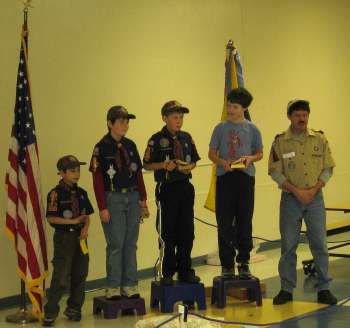
Roger Vandepoel (right) stands with Webelos II racers
All racers get a participation ribbon and a patch. Each racer gets either a trophy or a ribbon, depending on their score. At the next pack meeting everyone also gets a certificate."Everybody's a winner. That's the best part," says Hradisky.
----
v2i5



